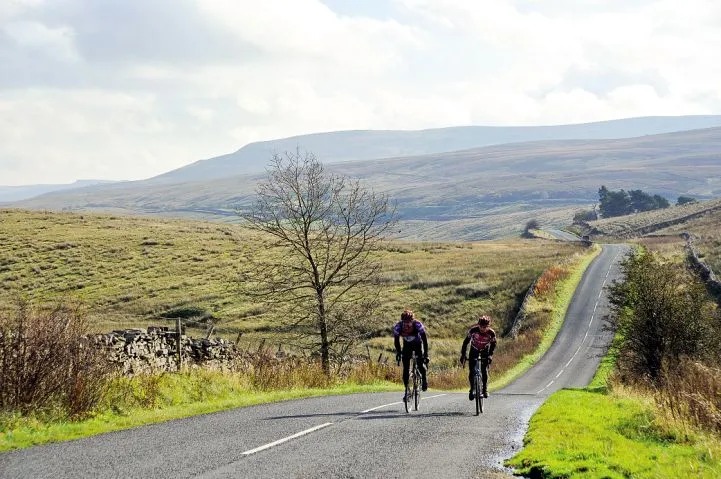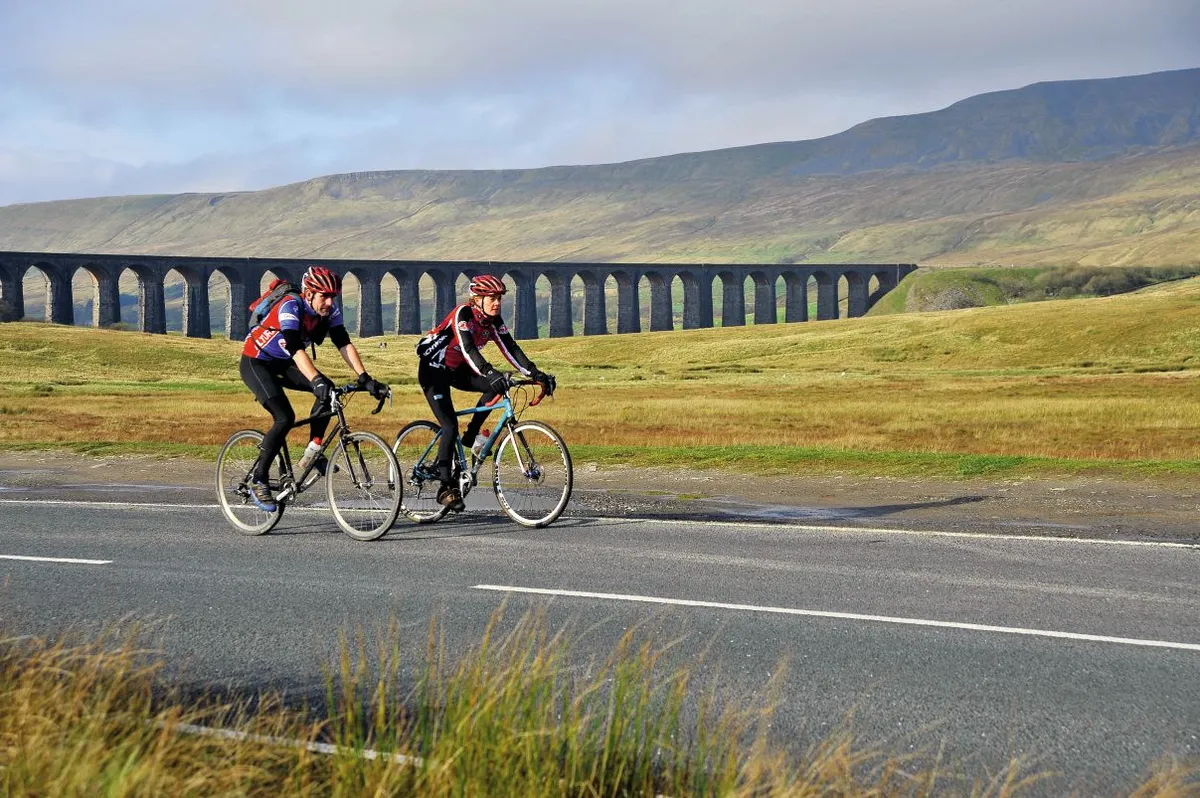Route information
- Distance 142km (88 miles)
- Climbing 1998m (6555ft)
- Grade Hard
- Maps OS Landranger 98 Wensleydale & Upper Wharfedale, 91 Appleby-in-Westmorland, 90 Penrith & Keswick, 86 Haltwhistle & Brampton, 85 Carlisle & Solway
- Download the route here
You do know this is a road ride, don’t you?” is my reaction, seeing Jon Bardgett and Nic Davies clamber from the train toting their cyclo-cross bikes. I’m only half serious. A cyclo-cross bike seems a perfectly sensible choice for a ride with some steep climbs and less than silky smooth roads. I’m just a little nervous because I know they’re serious ’crossers and wonder if I may struggle to keep them confined to tarmac. Time will tell.
The Settle to Carlisle line is one of England’s most scenic rail routes. It’s the highest line on the national rail network in England, and has the highest station. By rail, the distance is about 116km – 72 miles. By road, though – and I’ve planned a route that shadows the railway as closely as possible – it’s a good 25km further. The limitations of winter daylight mean we’re eager to get rolling, and the delights of Ye Olde Naked Man Café will have to keep for another day.
Bustling but compact, Settle has all the services you need but doesn’t detain you with urban sprawl when you want to get away. Road and rail dance cheek to cheek on the opening miles and one theme very quickly becomes clear: the road undulates a lot more than the rail line does.

Peak fitness
It’s about 10km to Horton-in-Ribblesdale. A staging post on the Pennine Way, for 364 days a year it’s also the start and finish for the Three Peaks Walk, but on one day at the end of September, walkers play second fiddle to bikes. The Three Peaks Cyclo-Cross, first staged in 1961, is one of the most famous – or perhaps infamous – events in the sport.
It turns out that Jon and Nic are regulars and even describe the Three Peaks as their favourite race. “It’s just wonderfully lunatic,” is Nic’s summary. Later, Jon tells me that Nic is record holder for her age group. If racing 60-odd kilometres over three burly mountains is their cup of tea, then I’m fairly sure a mere 140km on the roads won’t faze them.
Beyond Horton, the road continues its rolling progress before emerging into the open spaces of Ribblehead. Ingleborough is still lurking in the clouds off to our left, but Whernside – highest of the three peaks – is all but clear ahead. And slung between them as if tying the two peaks together is the most famous landmark on the Settle-Carlisle line.
At 400m long and 32m high, the Ribblehead Viaduct is dwarfed by the hills, yet still commands centre stage. In this high and windswept spot, shanty towns were established to house the navvies and their families. Over a thousand people lived here between 1870 and 1874 during the construction of the viaduct and the nearby Blea Moor Tunnel, and something like a hundred of them died. The tunnel may, in fact, be the greater engineering feat – it’s the longest on the line at over 2km – but of course it’s hidden while the viaduct is out in the open; grandly and flagrantly proclaiming itself.

Moor memories
Our route now turns right and keeps on climbing, over rolling waves of treeless brown moorland. This road is used (in the opposite direction) by the Circuit of the Dales, a long-established 50-mile time trial, making it my turn to reminisce. There was the time a howling north-easterly pushed speeds to 80kph on the descent we’re now climbing. And there was another occasion when, this being an early-season event, I was so chilled and close to bonking that I almost stalled on the climb. When a friendly soul – ancient black bike, cape, flat cap – offered me a barley sugar I couldn’t take a hand off the bar to accept it.
I’m glad it’s not that cold today, though there’s a crispness in the air as we swing left on a narrow lane and begin the descent into Dentdale, steep and twisting as it passes under the Dent Head Viaduct.

With its viaducts and tunnels, the railway maintains a near-level course across the fells, while the road drops almost 200m into the snug green confines of Dentdale. And then, of course, we have to climb out again. The first cut is the steepest, taking us up to Dent station, handily located over 6km and around 200m higher than the village. Perhaps not the sort of place where you’d nip along on your Brompton to catch a train…
Above the station, the road climbs more gradually, finally topping out at 537 metres above sea level. There’s a relatively level stretch, Galloway Gate, where we can soak up the epic views over Dentdale, Garsdale and Grisedale, before the pattern reverses with a steepening drop to Garsdale Station. A short spin along the A684 then we turn left at the Moorcock Inn. I think longingly of its ham sandwiches as we press on.
trundling trains
We roll over a slight rise to the head of Mallerstang. Framed by the heights of Wild Boar Fell and Mallerstang Edge, it’s a grand exit from the Yorkshire Dales. Road and rail run parallel, swapping sides now and then for variety. I photograph Jon and Nic on the empty road with the rails glinting in the sun alongside, and we’ve barely got rolling again when a train trundles past. Cue hollow laughter: “That would have made the shot.”
Lower down the valley, Pendragon Castle crouches on a low mound, supposedly built by Uther Pendragon, father of King Arthur. Hard evidence is lacking. It doesn’t look much like the castle in the BBC’s Merlin, either. Here it would seem logical to continue down to Kirkby Stephen, the first town since Settle. But, yet again, the line bypasses the town. The station may not be as remote as Dent, but then Kirkby Stephen is a much bigger place and you might expect the railway to take notice.
The Settle-Carlisle was a line with ambition, aiming to allow the Midland Railway to challenge existing London-Scotland routes. The line was built for express trains, double-tracked throughout, with shallow gradients and gentle curves (conspicuously unlike most of the more humble roads we’ve been following). It never quite worked out, and the grand scale of its 14 tunnels and 20-odd viaducts makes for high maintenance costs. The upkeep of Ribblehead in particular almost forced the closure of the line in the 1980s, but after a major public outcry the necessary funds were found and the line now attracts significant tourist traffic – not to mention a few visionary cyclists.
Ford warned
And so we swing left and climb out of Mallerstang. On the moor above we meet a small group of free range fell ponies. As I stop to photograph them, a man in a green pickup greets me cheerily: “You like me ponies, then?” It turns out he owns about 35 of them and is particularly proud of his prize stallion, known as The Gaffer.
We scuttle on and off the busy A685 and drop into Smardale. At the bottom there’s a ford, deep and slippery. Here’s a warning: Jon and Nic cycled to Mongolia and back a couple of years ago (see http://tinyurl.com/6fub5gc for their account), and never fell off once until they hit a similar ford just a stone’s throw from home. Indeed, Nic almost repeats the tumble here. As a timid roadie I’m glad to see there’s a footbridge alongside.
We’re out of the big hills now, into rolling green country, but Crosby Garrett is the only village before we hit the final descent into Appleby, traditional capital of the now officially vanished county of Westmorland. It’s very obvious that we’ve left the silvery limestone of the Dales behind and entered the red sandstone country of the Eden Valley.

take me higher
Refreshed by coffee and cakes at the cosy Courtyard Gallery, we climb gradually onto the lowest foothills of the North Pennines. Above us the fells form a great ridge, the longest single block of high ground in England. Its highest point, Cross Fell, is also the highest point outside the Lake District, and it’s here you find the highest tarmac roads in England.
Today, though, we’re soon looping away from the hills again, tracking the railway as it weaves through the lush woods and pastures of the Eden Valley. Snug villages tick by in steady succession now, but the lanes are quiet. The clouds are gathering and the day seems to be fading prematurely, but we still take a minute for a side-trip to the bridge at Armathwaite, to look down at the Eden running broad and shallow under a riot of autumn leaves.
And then, quite suddenly, I realise this is the home stretch, through Cotehill and Cumwhinton. The surroundings are still green as the road crosses over the M6, but Carlisle’s suburbs begin soon after. The final couple of kilometres are alongside the A6 and it’s rush hour, and even though it’s bike lanes most of the way it’s still quite a shock after a day of nearly empty roads.
Images of open moorland and picturesque views are etched on to our memories firmly enough to block out the hustle and bustle of city life for some time to come, though. And doubtless we’ll be exploring it all again another day.
Let the train take the strain
You could turn around at Carlisle and ride back to Settle, or let the train take the strain. There are nine intermediate stations on this ride, creating lots of bail-out options in case of bad weather, mechanical problems or fatigue, or allowing shorter sections of the route to be done in a planned fashion. Capacity for bikes is limited though. According to the Settle-Carlisle Partnership website (www.settle-carlisle.co.uk), ‘Normally, two bicycles can be carried (any more is subject to the discretion of the conductor)’. At off-peak times extra space is often available but can’t be guaranteed and you can’t book ahead.
Settle-Carlisle is only one of many great routes that can be done with rail assistance. Carlisle-Newcastle is another, following the line of Hadrian’s Wall, and while some great scenic rail routes, like the West Highland Line to Fort William, are more mountain bike-friendly, the onward route from Fort William to Mallaig would be a stunning road ride.
Local Knowledge
Nearest stations
Settle and Carlisle (also on West Coast Main Line). Giggleswick on the Leeds–Lancaster line (www.settle-carlisle.co.uk www.nationalrail.co.uk).
Food and drink
There are some long gaps between refreshment stops, including the whole of the crunch section from Ribblehead to Mallerstang. At the end of this, the Moorcock Inn (www.moorcockinn.com) is excellent, but shuts afternoons in winter. Appleby has several good cafes and pubs, and after that most of the villages have a decent pub, notably the Dukes Head in Armathwaite (www.dukeshead-hotel.co.uk).
Where to stay
Settle, Appleby and Carlisle all have a good choice of accommodation; elsewhere it’s down to scattered pubs and B&Bs. The Moorcock Inn (above) has ensuite rooms and, though slightly off route, Kirkby Stephen has a lot to offer, being a major waystation on the Coast to Coast walking route. There is a YHA hostel in Carlisle and one just off route at Dufton (www.yha.org.uk).
Bike shops
3Peaks Cycles, Settle and Coast to Coast Cycles, Kirkby Stephen Cycle Centre
Subscribe!
Cycling Plus has been seeking out Britain's Best Rides since 1992 – subscribe here!
Sign up to the Cycling Plus Newsletter here
